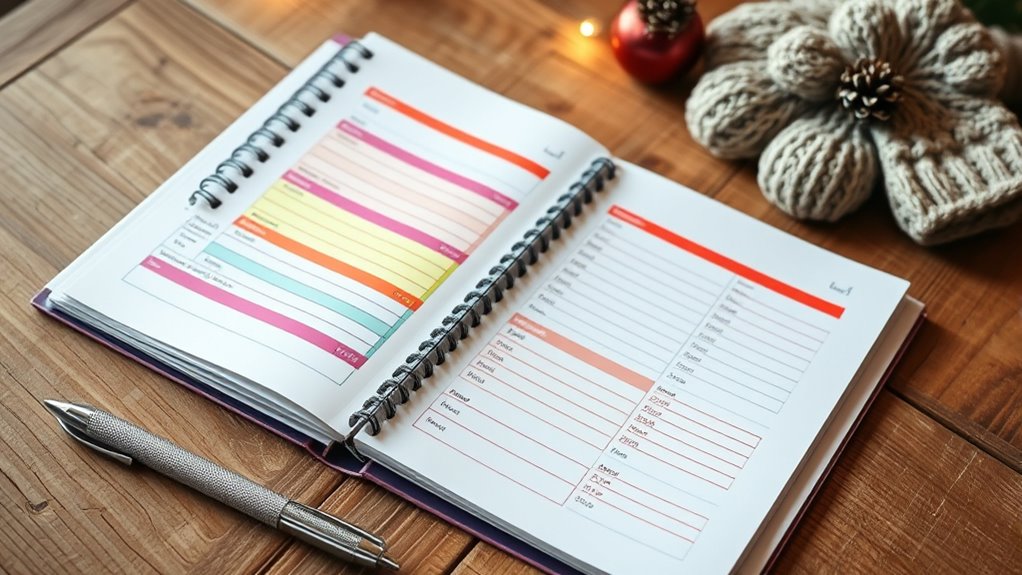A holiday budget planner template helps you stay organized and save money during the festive season. Look for tools that track discounts, categorize gifts by recipient, and include automatic totals for easy updates. You can choose between free options with basic features or paid versions offering customization and automation. Using digital tools also helps you monitor expenses and avoid overspending. Keep exploring to discover how to customize your plan and maximize your savings effectively.
Key Takeaways
- Choose between free and paid templates based on desired features, customization, and security needs.
- Use templates to categorize expenses, set spending limits, and prioritize gifts by recipient and deadlines.
- Track discounts, cashback offers, and deals during holiday sales to maximize savings.
- Utilize digital tools for real-time expense tracking, receipt management, and automated alerts.
- Regularly review and adjust your budget to stay aligned with financial goals and prevent overspending.
Top Features to Look for in Holiday Budget Templates
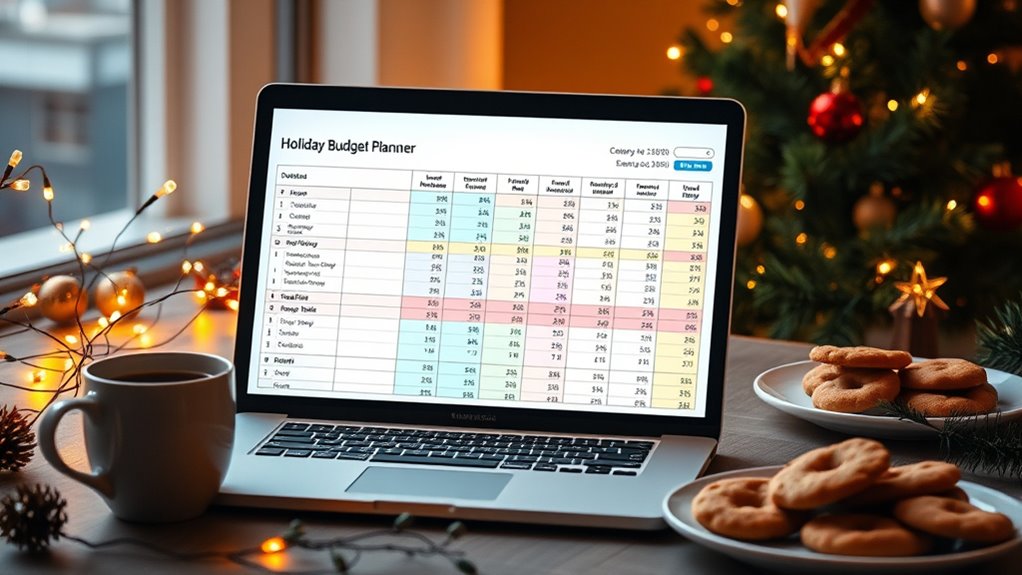
What should you prioritize when choosing a holiday budget template? First, look for features that help you maximize seasonal savings. A good template should include sections for tracking discounts, cashback offers, or special deals so you can take advantage of holiday sales. Additionally, gift categorization is essential; it allows you to organize your spending by recipient, such as family, friends, or colleagues. This helps prevent overspending and keeps your budget balanced. Look for templates that offer clear categories, automatic totals, and easy customization. These features ensure you stay organized and focused on your financial goals during the busy holiday season. Incorporating proper budget planning can further enhance your ability to stay within your holiday spending limits. For example, choosing a template with automated expense tracking can save you time and reduce errors.
Free vs. Paid Budget Planner Templates: Pros and Cons
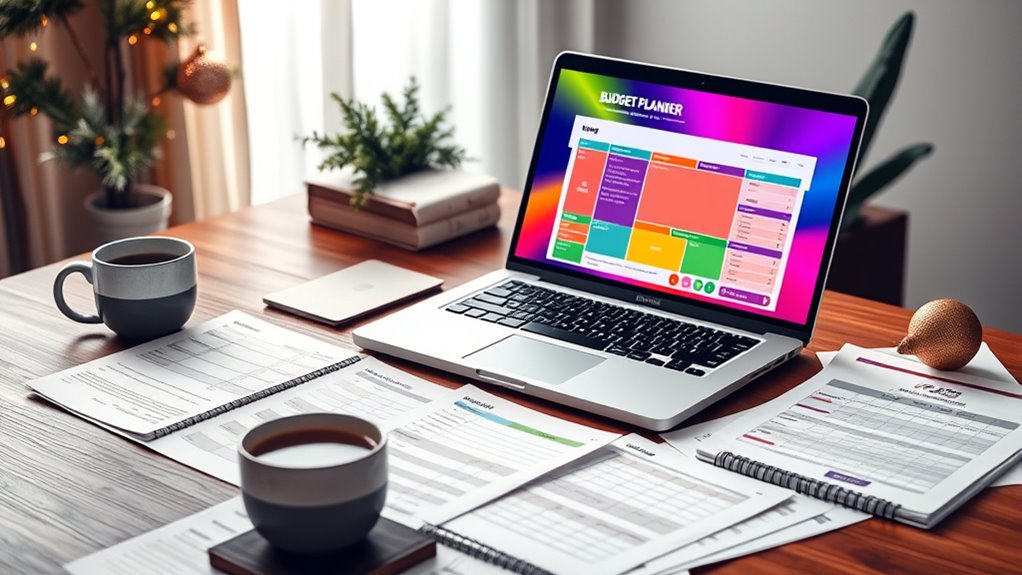
Choosing between free and paid budget templates depends on what features and flexibility matter most to you. Free options often offer basic tools with limited customization, while paid versions usually come with advanced features and better support. Consider your budget and needs to decide which option provides the best value for your holiday shopping plans. Additionally, selecting the right tools can help streamline your planning process and ensure you stay on track.
Flexibility and Features
While both free and paid budget planner templates aim to help you organize holiday spending, they differ markedly in flexibility and features. Free templates often offer basic tools, limiting your budget flexibility and feature variety. Paid options tend to include advanced features like customizable categories, automatic calculations, and detailed reports, giving you more control. Consider these points:
- Free templates usually have limited customization options.
- Paid templates often include automatic updates and integrations.
- Free versions may lack detailed expense tracking.
- Paid templates provide more all-encompassing tools for complex budgets.
- Additionally, security features in paid templates can help protect your financial data better than free versions.
- Understanding budgeting best practices can enhance the effectiveness of whichever template you choose.
- Incorporating organization strategies can further optimize your holiday spending plan and keep you on track.
If you want a straightforward plan, free templates might suffice. But for greater control, detailed insights, and a broader feature set, investing in a paid template could be worthwhile.
Cost and Accessibility
Deciding between free and paid budget planner templates largely depends on your needs and budget. A cost comparison shows free options are budget-friendly and easily accessible, making them ideal if you’re just starting or on a tight budget. However, accessibility challenges may arise with free templates if they lack user support or customization features. Paid templates often come with enhanced features, priority support, and better design, but they require a financial investment. If you value convenience and advanced tools, paying for a premium template might be worth it. Conversely, free templates can be sufficient for straightforward holiday shopping plans. Additionally, understanding the types of cookies used on budgeting websites can help you manage your privacy while accessing these tools. Moreover, some nutritional insights can guide you in choosing healthier options for holiday treats and gifts. When selecting a template, considering its user interface can significantly impact your overall experience and efficiency. Ultimately, consider your specific needs and comfort with technology to choose the best option for organizing your holiday budget effectively.
Digital Tools and Apps for Holiday Budgeting
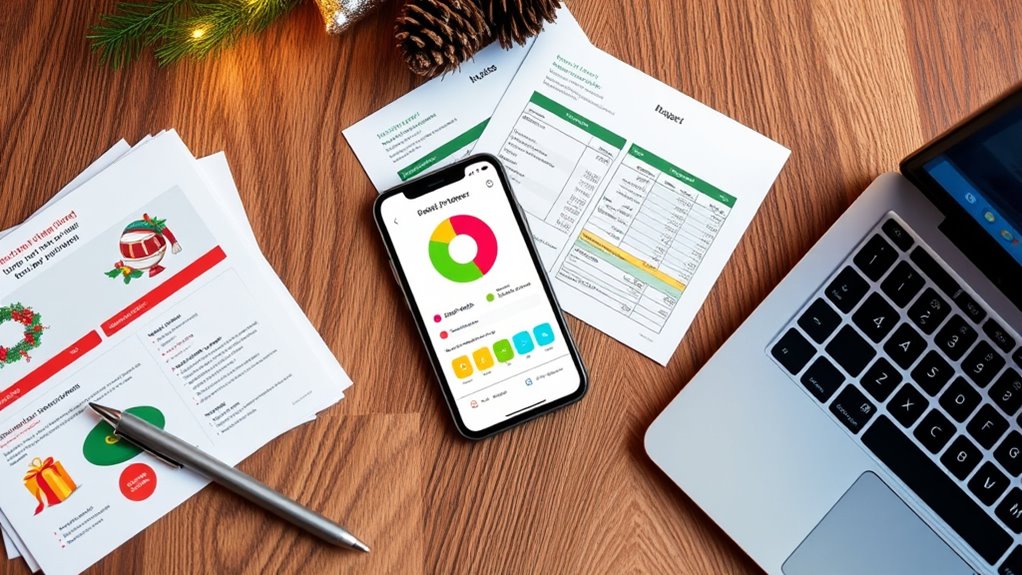
Digital tools and apps have made holiday budgeting more accessible and efficient, allowing you to track expenses in real-time and set spending limits effortlessly. With these apps, you can organize costs for gift wrapping supplies, plan your holiday meal budgets, and allocate funds for festive activities. Here are four ways they help:
- Expense Tracking – Monitor spending across categories like gifts, decorations, and meal ingredients.
- Budget Alerts – Receive notifications when you’re nearing your limit, preventing overspending.
- Shared Budgeting – Collaborate with family members to stay aligned on holiday expenses.
- Receipt Management – Scan and store receipts digitally for easy record-keeping. Incorporating digital security measures ensures your financial data remains protected while managing your holiday budget online.
– Understanding grocery savings strategies can further help you cut costs and maximize your holiday budget.
These features help you stay focused, reduce stress, and make sure you don’t go over budget during the busy holiday season.
Customizing Your Budget Planner for Personal Needs

Once you’ve chosen the right digital tools and apps for holiday budgeting, the next step is tailoring your budget planner to fit your personal needs. Most platforms offer various personalization options, allowing you to add expense categories, set spending limits, and customize color schemes or layouts. However, customization challenges can arise, such as balancing simplicity with detail or adapting templates to unique spending habits. To overcome these hurdles, focus on selecting features that align with your specific shopping list and financial goals. Don’t be afraid to experiment with different formats or remove unnecessary sections. The goal is to create a planner that’s intuitive and motivating, helping you stay on track throughout the holiday season while reflecting your individual budgeting style. Incorporating audience segmentation into your planning process can also help you better target your shopping efforts and allocate funds more effectively. Additionally, understanding spoiled lemon juice signs can help you avoid wasting money on spoiled ingredients, ensuring your holiday cooking stays fresh and safe. Being aware of eye patch benefits can also inspire self-care routines that keep you energized during busy shopping days.
Tips for Using Budget Templates to Maximize Savings
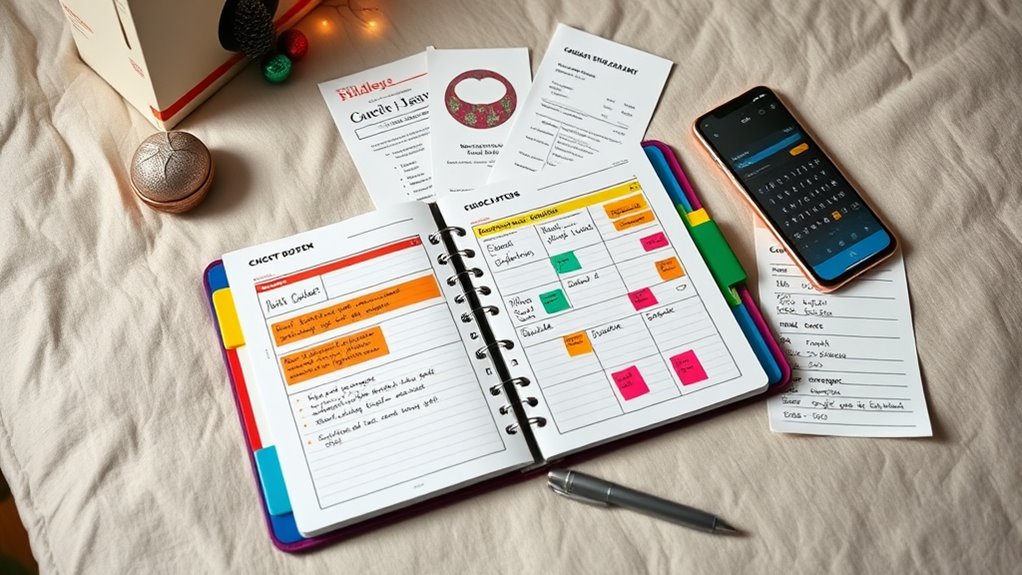
To maximize your savings using budget templates, start by setting clear spending limits for each category based on your overall holiday budget. This helps you stay on track and avoid overspending. Consider these tips:
- Prioritize holiday meal planning to allocate funds efficiently, focusing on cost-effective recipes and ingredients.
- Use your budget to set aside a specific amount for gift wrapping ideas, opting for simple, homemade touches to save money.
- Track expenses regularly to identify areas where you can cut back or reallocate funds.
- Stick to your limits by reviewing your template before making any purchase, ensuring you stay within your planned budget.
- Incorporate budgeting strategies that account for seasonal spending fluctuations to better prepare for unexpected expenses during the holidays.
Real-Life Examples of Successful Holiday Budgeting
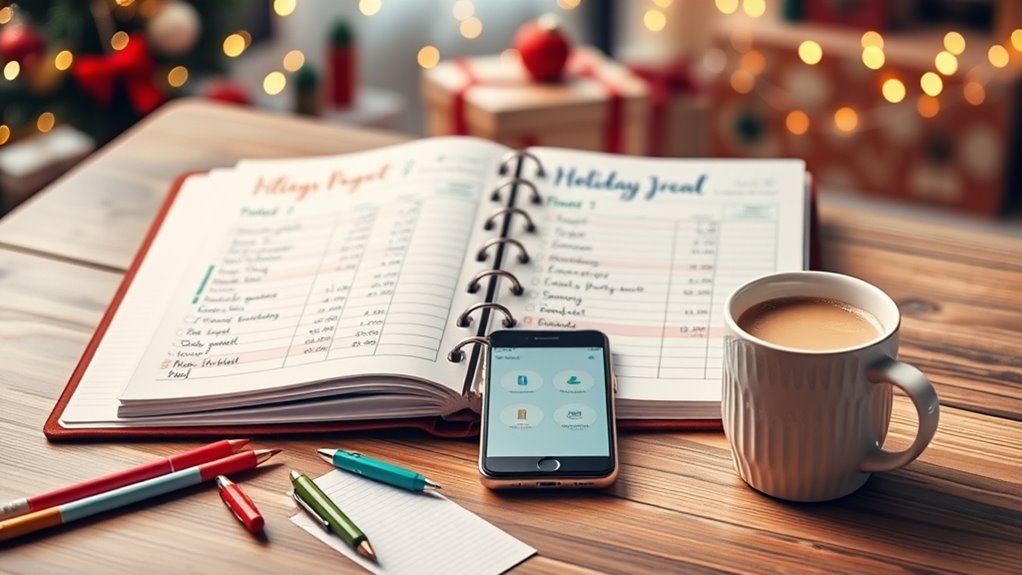
Many people succeed in holiday budgeting by setting clear spending limits and sticking to them. They prioritize gift purchases to guarantee they cover what matters most, while tracking expenses helps avoid overspending. These real-life examples show how disciplined planning keeps holiday costs manageable and stress-free. Additionally, incorporating budget planner templates can streamline the process and help maintain financial balance throughout the season. Using tools like financial management can further enhance their ability to stay on track and avoid unexpected expenses during the holidays. Engaging in expense tracking methods can provide ongoing awareness of spending habits, ensuring better control over holiday budgets.
Setting Clear Spending Limits
Setting clear spending limits is essential to keep your holiday budget on track, and real-life examples show how effective planning can make a difference. When you set a cap, you can focus on affordable holiday gift ideas and stay within your seasonal expense tracking. For example:
- Assign a fixed amount per person to avoid overspending.
- Use a spreadsheet to monitor expenses daily.
- Cut back on non-essential items to stay within your budget.
- Prioritize meaningful gifts over expensive ones to maximize value.
- Utilize efficient payment methods like ACH and wire transfers to manage your holiday expenses securely and conveniently.
Additionally, regularly review and adjust goals to ensure your spending remains aligned with your overall financial plan.
Prioritizing Gift Purchases
Prioritizing your gift purchases helps guarantee you stay within your holiday budget without missing out on meaningful presents. By focusing on gift prioritization, you can allocate funds effectively, especially around shopping deadlines. Start with the most important recipients and set deadlines to ensure timely buying. Use this table as a guide:
| Priority Level | Gift Recipient | Shopping Deadline | Notes |
|---|---|---|---|
| High | Immediate family | December 10 | Budget-friendly options |
| Medium | Close friends | December 15 | Group gifts if possible |
| Low | Coworkers, acquaintances | December 20 | Small, thoughtful gifts |
| Last-Minute | Unexpected gifts | December 22 | Use online quick shipping |
| Special Deals | Wait for sales | Varies | Track holiday sales |
Focusing on shopping deadlines and gift prioritization helps you avoid last-minute stress and overspending. Being aware of tableware trends and sales can also help you find thoughtful gifts at better prices. Additionally, planning ahead allows you to incorporate rustic decor ideas for personalized presents that suit the farmhouse aesthetic. Keeping an eye on highlighted hair color trends can inspire gift ideas for beauty enthusiasts during the holidays.
Tracking Expenses Effectively
Tracking your expenses is essential to stay within budget and avoid overspending during the holiday season. It helps you monitor spending on holiday meal planning, gifts, travel, and entertainment. To do this effectively, consider these strategies:
- Use a dedicated budget tracker to log every expense daily.
- Separate categories like travel expense management and holiday meal planning for clarity.
- Review your spending weekly to identify areas where you can cut back.
- Set alerts for when you’re nearing your budget limits to stay on track.
- Incorporate data-driven strategies to analyze your spending patterns and optimize your holiday budget.
Implementing tools that provide financial insights can further enhance your ability to manage holiday expenses effectively. Real-life examples show that consistent tracking keeps holiday costs manageable and reduces financial stress. By staying vigilant, you ensure your holiday season is joyful without breaking the bank.
Frequently Asked Questions
Can Budget Templates Be Used for Non-Holiday Seasons?
Yes, you can definitely use budget templates for non-holiday seasons. They’re great tools for managing your seasonal savings and keeping track of expenses year-round. By customizing these templates, you can set aside funds for vacations, birthdays, or unexpected costs, ensuring you stay financially organized no matter the time of year. This way, you maintain consistent budgeting habits, making your financial planning more flexible and effective throughout the entire year.
How Do I Track Unexpected Holiday Expenses Effectively?
To track unexpected holiday expenses effectively, start by setting aside emergency funds specifically for surprises. Use expense categorization to organize your spending, making it easier to identify and manage unanticipated costs. Regularly review your budget, adjusting as needed, and keep receipts or records handy. This proactive approach helps prevent overspending and guarantees you’re prepared for any holiday surprises that come your way.
Are There Budget Templates Suitable for Large Families?
You can find budget templates suited for large families by focusing on family expense categories and customizing your shopping list. These templates help you allocate funds for each family member, holiday gifts, and shared activities, making it easier to stay organized. With a detailed shopping list integrated into the template, you’ll guarantee no expense is overlooked, keeping your holiday spending on track and stress-free for everyone involved.
Can Budget Planners Help Manage Gift Exchange Costs?
Sure, budget planners can effectively manage gift exchange costs by clearly setting spending limits and tracking transactions. You’ll stay on schedule and save markedly by sticking to your predetermined spending limits, reducing regret and financial stress. With a budget planner, you can easily balance your budget, avoid overspending, and make merry memories without monetary mishaps. Planning proactively prevents problems and promotes a more peaceful, playful holiday season.
How Often Should I Update My Holiday Budget?
You should update your holiday budget regularly, ideally weekly, to stay on top of your holiday savings goals. This helps you track expenses across different categories like gifts, decorations, and travel, ensuring you don’t overspend. By adjusting your budget as needed, you can better manage your expenses and keep your holiday season enjoyable without financial stress. Consistent updates keep your spending aligned with your holiday plans.
Conclusion
By using the perfect holiday budget planner, you’ll effortlessly dodge financial chaos, turn your holiday shopping into a stress-free joyride, and save enough to buy that extra gift everyone will rave about. With these tools, you’ll conquer your spending fears, master your finances like a holiday budgeting superhero, and perhaps even have enough left to treat yourself. Get ready to make this season the most organized, joyful, and wallet-friendly one you’ve ever had!
